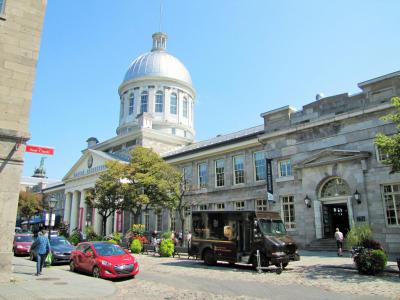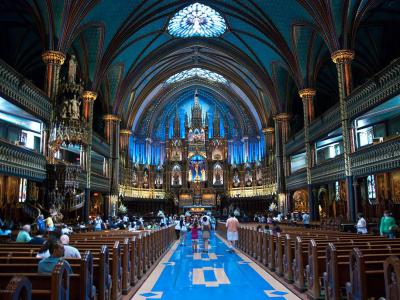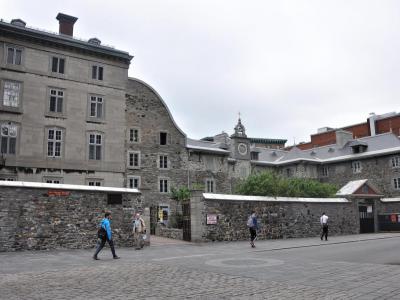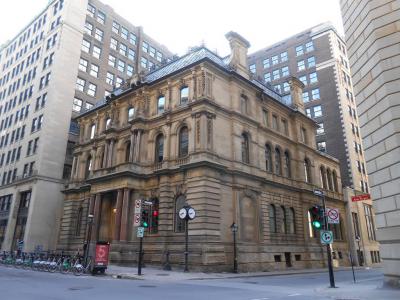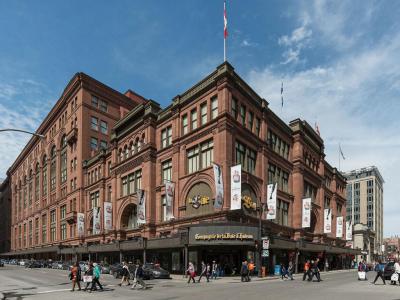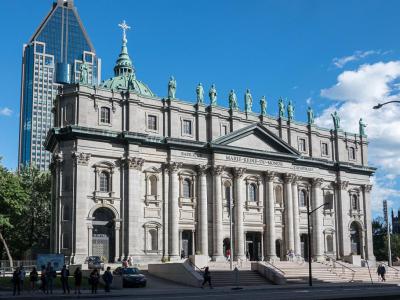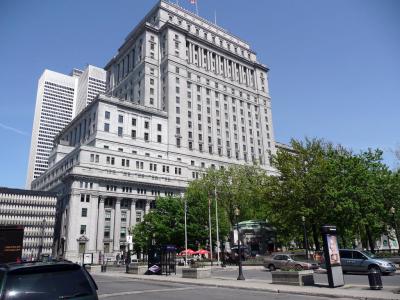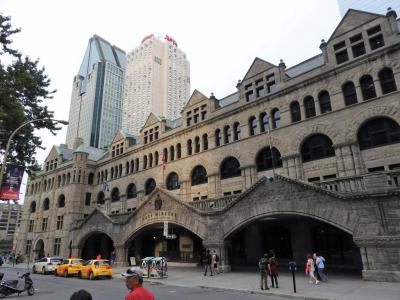Historical Buildings Walking Tour (Self Guided), Montreal
Whenever you gaze upon the historical buildings of Montreal, you are reminded that the true measure of a city's greatness lies in its ability to preserve its past while embracing its future. Old Montreal – home to four centuries of architecture shaped by French sophistication and English practicality – is a place all its own.
Here, modern buildings coexist with some of the oldest and most fascinating structures like the domed Bonsecours Market (Marché Bonsecours) and the impressive Second Empire-style Montreal City Hall (Hôtel de Ville). These historic landmarks stand out tall as silent witnesses to the passage of time and enduring sights that continue to thrive and define the city's architectural identity. Much the same is the Old Saint-Sulpice Seminary, featuring a blend of French and Quebecois grandeur.
Another guardian of local heritage, preserving the soul of a place, is the Montreal History Center (Centre d'Histoire de Montréal). Just a few blocks away, at the corner of Saint Jacques and Saint Pierre streets, you will find a Beaux-Arts architectural gem known as the Molson Bank.
Among other prominent “storytellers frozen in time” who share tales of the past generations with every brick and arch are the Hudson's Bay (La Baie d'Hudson), the Sun Life Building, and Windsor Station (Gare Windsor).
Montreal's historical buildings are like pages of a living book, each one telling its own chapter of the city's story. If you wish to hear some of them and appreciate first-hand the enduring elegance and artistic vision of those who shaped the skyline of the Quebec capital, embark on this captivating self-guided journey with GPSmyCity.
Here, modern buildings coexist with some of the oldest and most fascinating structures like the domed Bonsecours Market (Marché Bonsecours) and the impressive Second Empire-style Montreal City Hall (Hôtel de Ville). These historic landmarks stand out tall as silent witnesses to the passage of time and enduring sights that continue to thrive and define the city's architectural identity. Much the same is the Old Saint-Sulpice Seminary, featuring a blend of French and Quebecois grandeur.
Another guardian of local heritage, preserving the soul of a place, is the Montreal History Center (Centre d'Histoire de Montréal). Just a few blocks away, at the corner of Saint Jacques and Saint Pierre streets, you will find a Beaux-Arts architectural gem known as the Molson Bank.
Among other prominent “storytellers frozen in time” who share tales of the past generations with every brick and arch are the Hudson's Bay (La Baie d'Hudson), the Sun Life Building, and Windsor Station (Gare Windsor).
Montreal's historical buildings are like pages of a living book, each one telling its own chapter of the city's story. If you wish to hear some of them and appreciate first-hand the enduring elegance and artistic vision of those who shaped the skyline of the Quebec capital, embark on this captivating self-guided journey with GPSmyCity.
How it works: Download the app "GPSmyCity: Walks in 1K+ Cities" from Apple App Store or Google Play Store to your mobile phone or tablet. The app turns your mobile device into a personal tour guide and its built-in GPS navigation functions guide you from one tour stop to next. The app works offline, so no data plan is needed when traveling abroad.
Historical Buildings Walking Tour Map
Guide Name: Historical Buildings Walking Tour
Guide Location: Canada » Montreal (See other walking tours in Montreal)
Guide Type: Self-guided Walking Tour (Sightseeing)
# of Attractions: 10
Tour Duration: 2 Hour(s)
Travel Distance: 3.8 Km or 2.4 Miles
Author: doris
Sight(s) Featured in This Guide:
Guide Location: Canada » Montreal (See other walking tours in Montreal)
Guide Type: Self-guided Walking Tour (Sightseeing)
# of Attractions: 10
Tour Duration: 2 Hour(s)
Travel Distance: 3.8 Km or 2.4 Miles
Author: doris
Sight(s) Featured in This Guide:
- Bonsecours Market (Marche Bonsecours)
- City Hall (Hotel de Ville)
- Notre-Dame Basilica
- Old Saint-Sulpice Seminary
- Caserne Centrale de Pompiers (Central Fire Station)
- Molson Bank
- Hudson's Bay (La Baie d'Hudson)
- Mary, Queen of the World Cathedral (Cathedrale Marie-Reine-du-Monde)
- Sun Life Building
- Windsor Station (Gare Windsor)
1) Bonsecours Market (Marche Bonsecours)
Bonsecours Market (Marché Bonsecours) owes its name to the adjacent Chapel of Our Lady of Good Help (Notre-Dame-de-Bon-Secours).
Inaugurated in 1847, for over a century this was the primary agricultural market for the Montreal area. Also, for a brief period – just one session, in 1849 – the building housed the Legislative Assembly (Parliament) of United Canada and, throughout 1852-1878, accommodated the Montreal City Hall.
The elongated two-story Neoclassical edifice with a tin-plated dome and columns is considered one of the main achievements of Canadian architecture. In 1984, it was designated a National Historic Site of Canada. The design – by British architect William Footner – was influenced by Dublin's Customs House. Further additions, including a 900-square-meter concert and banquet hall, completed in 1860, were designed by Irish-born Montreal architect George Browne.
The building continued to serve as the farmer's central market, as well as a venue for banquets, exhibitions, and festivals until it was closed in 1963. After standing idle for a few years, it was slated for demolition.
Luckily, the property was later transformed into a multi-purpose facility with a mall incorporating outdoor cafés, restaurants, and exclusive boutiques selling authentic Canadian crafts such as jewelry, leather, and hand-blown glass – all made in Quebec. Those keen on maple tree products will be particularly delighted to find here a huge variety of relevant merchandise including beer, wine, butter, and even lollipops.
However, if shopping isn't your prime interest, you may just as well walk around the site and find some pretty angles to photograph the building's grand-looking exterior. Or, perhaps, grab yourself a seat in one of the cafés and restaurants lining the facade and have a good time.
Inaugurated in 1847, for over a century this was the primary agricultural market for the Montreal area. Also, for a brief period – just one session, in 1849 – the building housed the Legislative Assembly (Parliament) of United Canada and, throughout 1852-1878, accommodated the Montreal City Hall.
The elongated two-story Neoclassical edifice with a tin-plated dome and columns is considered one of the main achievements of Canadian architecture. In 1984, it was designated a National Historic Site of Canada. The design – by British architect William Footner – was influenced by Dublin's Customs House. Further additions, including a 900-square-meter concert and banquet hall, completed in 1860, were designed by Irish-born Montreal architect George Browne.
The building continued to serve as the farmer's central market, as well as a venue for banquets, exhibitions, and festivals until it was closed in 1963. After standing idle for a few years, it was slated for demolition.
Luckily, the property was later transformed into a multi-purpose facility with a mall incorporating outdoor cafés, restaurants, and exclusive boutiques selling authentic Canadian crafts such as jewelry, leather, and hand-blown glass – all made in Quebec. Those keen on maple tree products will be particularly delighted to find here a huge variety of relevant merchandise including beer, wine, butter, and even lollipops.
However, if shopping isn't your prime interest, you may just as well walk around the site and find some pretty angles to photograph the building's grand-looking exterior. Or, perhaps, grab yourself a seat in one of the cafés and restaurants lining the facade and have a good time.
2) City Hall (Hotel de Ville)
The Montreal City Hall (Hôtel de Ville de Montréal) is the very first seat of municipal administration purposely constructed in Canada. Presently, it houses the offices of the Mayor and the City Council, as well as several other administrative departments.
The five-story edifice was originally built between 1872 and 1878 to a design by architects Henri-Maurice Perrault and Alexander Cowper Hutchison and is considered one of the best examples of the Second Empire style of architecture in the country.
The building's facade is made of gray limestone and its front and sides are beautifully decorated with turrets, balconies, and mansard roofs. The grand clock tower, rising 45 meters above the ground, is topped by a statue of the city's founder, Paul Chomedey de Maisonneuve.
Sadly, the original building was gutted by fire in March 1922, leaving only the outer wall and destroying many of the city's historical records. The replacement building, featuring a self-supporting steel structure (inside the shell of the ruins), was modelled after the city hall of the French city of Tours. It opened in February 1926.
The building's interior is equally impressive. Inside, the Hall of Honour is an open space full of marble and gold embellishments that houses Art Deco lamps from Paris and a bronze-and-glass chandelier, also from France, weighing a metric ton. In the council room, the five stained-glass windows, installed in the 1920s, depict the fundamental aspects of the city, such as Religion, Agriculture, Sea Port, Commerce, and Finance. In 1984, the building was designated a National Historic Site of Canada.
Unlike many government sites with restricted public entry, the Montreal City Hall permits visitors to take a quick guided tour – in both, English and French – free of charge. The tour schedules are displayed at the entrance.
Behind the building is a pocket of green, known as the Field of Mars (Champ-de-Mars), which used to serve as a military parade ground and a parking lot before being converted into a park in the 1980s. During the conversion, workers unearthed the remains of the city's old fortifications; parts of the restored city walls were later incorporated into the site.
The five-story edifice was originally built between 1872 and 1878 to a design by architects Henri-Maurice Perrault and Alexander Cowper Hutchison and is considered one of the best examples of the Second Empire style of architecture in the country.
The building's facade is made of gray limestone and its front and sides are beautifully decorated with turrets, balconies, and mansard roofs. The grand clock tower, rising 45 meters above the ground, is topped by a statue of the city's founder, Paul Chomedey de Maisonneuve.
Sadly, the original building was gutted by fire in March 1922, leaving only the outer wall and destroying many of the city's historical records. The replacement building, featuring a self-supporting steel structure (inside the shell of the ruins), was modelled after the city hall of the French city of Tours. It opened in February 1926.
The building's interior is equally impressive. Inside, the Hall of Honour is an open space full of marble and gold embellishments that houses Art Deco lamps from Paris and a bronze-and-glass chandelier, also from France, weighing a metric ton. In the council room, the five stained-glass windows, installed in the 1920s, depict the fundamental aspects of the city, such as Religion, Agriculture, Sea Port, Commerce, and Finance. In 1984, the building was designated a National Historic Site of Canada.
Unlike many government sites with restricted public entry, the Montreal City Hall permits visitors to take a quick guided tour – in both, English and French – free of charge. The tour schedules are displayed at the entrance.
Behind the building is a pocket of green, known as the Field of Mars (Champ-de-Mars), which used to serve as a military parade ground and a parking lot before being converted into a park in the 1980s. During the conversion, workers unearthed the remains of the city's old fortifications; parts of the restored city walls were later incorporated into the site.
3) Notre-Dame Basilica (must see)
The Notre Dame Basilica of Montreal (Basilique Notre-Dame de Montréal) is a stunning piece of Gothic Revival architecture. Designed by the Irish-American architect James O'Donnell, it was completed, for the most part, in 1829.
The sanctuary was constructed a year later, while the first and second towers were added in 1841 and 1843, respectively. Both towers have bells: the West Tower (La Persévérance), has a bourdon bell nicknamed Jean-Baptiste. It was cast in John Dod Ward’s Eagle Foundry in 1848 and weighs 10,900 kg. Jean-Baptiste tolls only on special occasions, such as funerals, great religious festivals, and Christmas Eve. The East Tower (La Temperance), houses a ten-bell carillon from the same foundry, made in 1842.
The facade of the church was completed in 1865 and includes, among other features, three statues by the French sculptor Henri Bouriché, namely: the Virgin Mary (representing Montreal), Saint John the Baptist (representing Quebec), and Saint Joseph (representing Canada).
The interior – colorful and lavish – took much longer to complete and is quite impressive with its richly decorated columns, intricate wood carvings, statues, and elaborate stained glass windows. Quite unusual for a church, the stained glass windows here depict scenes from the history of Montreal rather than biblical scenes. Another spectacular highlight of the basilica is the Casavant Frères pipe organ, created in 1891, which is one of the largest organs in North America, comprising four keyboards and 7,000 individual pipes.
The Notre-Dame church was raised to the status of a minor basilica, by Pope John Paul II, in 1982 and was designated a National Historic Site of Canada in 1989.
Today, the Notre Dame of Montreal is a popular landmark, attracting yearly more than 11 million tourists from around the globe, making it one of the most visited sites in North America. Even the $10 admission fee doesn't turn visitors away.
Over the years, the basilica has hosted a number of important events, such as Céline Dion's wedding in 1994 and the funeral of the former Canadian Prime Minister, Pierre Trudeau, in 2000.
If you're interested in classical and religious music, the basilica offers musical programming of choral and organ performances, including Handel's Messiah every Christmas.
Tip:
The provided on-site brochure is very informative and can be used as a self-guide. Additionally, there's a free 20-minute English/French tour available at entry.
The 'AURA' light show (starting usually at 7 and 9 pm) is exceptional but often sold out, so plan your visit in advance: you can book a ticket online or come early to get a place. Try sitting somewhere in the middle to get the best music & light experience.
The sanctuary was constructed a year later, while the first and second towers were added in 1841 and 1843, respectively. Both towers have bells: the West Tower (La Persévérance), has a bourdon bell nicknamed Jean-Baptiste. It was cast in John Dod Ward’s Eagle Foundry in 1848 and weighs 10,900 kg. Jean-Baptiste tolls only on special occasions, such as funerals, great religious festivals, and Christmas Eve. The East Tower (La Temperance), houses a ten-bell carillon from the same foundry, made in 1842.
The facade of the church was completed in 1865 and includes, among other features, three statues by the French sculptor Henri Bouriché, namely: the Virgin Mary (representing Montreal), Saint John the Baptist (representing Quebec), and Saint Joseph (representing Canada).
The interior – colorful and lavish – took much longer to complete and is quite impressive with its richly decorated columns, intricate wood carvings, statues, and elaborate stained glass windows. Quite unusual for a church, the stained glass windows here depict scenes from the history of Montreal rather than biblical scenes. Another spectacular highlight of the basilica is the Casavant Frères pipe organ, created in 1891, which is one of the largest organs in North America, comprising four keyboards and 7,000 individual pipes.
The Notre-Dame church was raised to the status of a minor basilica, by Pope John Paul II, in 1982 and was designated a National Historic Site of Canada in 1989.
Today, the Notre Dame of Montreal is a popular landmark, attracting yearly more than 11 million tourists from around the globe, making it one of the most visited sites in North America. Even the $10 admission fee doesn't turn visitors away.
Over the years, the basilica has hosted a number of important events, such as Céline Dion's wedding in 1994 and the funeral of the former Canadian Prime Minister, Pierre Trudeau, in 2000.
If you're interested in classical and religious music, the basilica offers musical programming of choral and organ performances, including Handel's Messiah every Christmas.
Tip:
The provided on-site brochure is very informative and can be used as a self-guide. Additionally, there's a free 20-minute English/French tour available at entry.
The 'AURA' light show (starting usually at 7 and 9 pm) is exceptional but often sold out, so plan your visit in advance: you can book a ticket online or come early to get a place. Try sitting somewhere in the middle to get the best music & light experience.
4) Old Saint-Sulpice Seminary
Montréal's second-oldest structure, the Sulpician Seminary located next to Notre-Dame Basilica was declared a National Historic Site of Canada in 1980, taking into consideration the quality of the architecture, which is a rare and remarkable example of 17th-century classical design built during the French Regime, but also the remarkable integrity of its convent garden, which once served as a means of subsistence, besides its use for meditation and leisure.
Since the 1680s, the seminary has served as the residence and administrative centre of the Messieurs of Saint-Sulpice who were the seigneurs of the Island of Montréal until the end of the seigneurial regime. The main building, which is the oldest part, is also the one that has been the least changed over the centuries. Its façade, of rough-cut limestone masonry, has a remarkable neoclassical-style entrance gate, built in 1740, through which you can peek at the clock – one of the oldest of its kind in North America. A real window on Montréal's past, and the oldest Seminary where priests still live today!
Since the 1680s, the seminary has served as the residence and administrative centre of the Messieurs of Saint-Sulpice who were the seigneurs of the Island of Montréal until the end of the seigneurial regime. The main building, which is the oldest part, is also the one that has been the least changed over the centuries. Its façade, of rough-cut limestone masonry, has a remarkable neoclassical-style entrance gate, built in 1740, through which you can peek at the clock – one of the oldest of its kind in North America. A real window on Montréal's past, and the oldest Seminary where priests still live today!
5) Caserne Centrale de Pompiers (Central Fire Station)
Standing prominently on Place d’Youville, the former Central Fire Station in Montreal is a distinctive landmark that blends architectural charm with deep historical roots. Built between 1903 and 1904 by architects Joseph Perrault and Simon Lesage, the building was originally designed as the headquarters for the Montreal Fire Department. Its Flemish-inspired architecture-uncommon in the city at the time-features buff sandstone, red brick, a mansard roof with a skylight, and a striking square tower capped by a hipped roof. This stylistic choice set it apart from surrounding structures and continues to draw the eye today.
When the station opened in 1904, it operated with horse-drawn steam pumps, symbolizing the era’s firefighting technology. By 1908, it had transitioned to a district station, and the gradual modernization of equipment saw motor vehicles replace horses by 1931. The building remained in active service until 1972, faithfully serving Montreal’s growing urban population. Following its decommissioning, the structure stood unused until its revival in the early 1980s.
In 1983, the fire station was reborn as the Montreal History Centre, a museum dedicated to preserving and presenting the city’s heritage. This new function not only ensured the building’s preservation but also allowed visitors to engage with Montreal’s past in a setting rich with historical resonance. The unique combination of civic architecture and cultural programming made it a meaningful stop for both locals and tourists.
Though the museum has since moved to a new location, the former Central Fire Station remains a symbol of Montreal’s adaptive reuse of heritage buildings. Its story reflects the city’s ongoing dialogue between preservation and progress-a place where bricks and mortar continue to speak of lives, labor, and transformation across generations.
When the station opened in 1904, it operated with horse-drawn steam pumps, symbolizing the era’s firefighting technology. By 1908, it had transitioned to a district station, and the gradual modernization of equipment saw motor vehicles replace horses by 1931. The building remained in active service until 1972, faithfully serving Montreal’s growing urban population. Following its decommissioning, the structure stood unused until its revival in the early 1980s.
In 1983, the fire station was reborn as the Montreal History Centre, a museum dedicated to preserving and presenting the city’s heritage. This new function not only ensured the building’s preservation but also allowed visitors to engage with Montreal’s past in a setting rich with historical resonance. The unique combination of civic architecture and cultural programming made it a meaningful stop for both locals and tourists.
Though the museum has since moved to a new location, the former Central Fire Station remains a symbol of Montreal’s adaptive reuse of heritage buildings. Its story reflects the city’s ongoing dialogue between preservation and progress-a place where bricks and mortar continue to speak of lives, labor, and transformation across generations.
6) Molson Bank
Molson Bank sits at the heart of the city's (and country's) former business center, in the western part of Rue Saint-Jacques, which speaks favorably of, and largely added to, its commercial prestige over the years. The bank's mansion-like appearance is in dramatic contrast with the very tall neighboring structures built in later periods; that notwithstanding, the Ohio buff sandstone facing, an innovation at the time, harmonizes well with the variety of stone used later in the area.
As part of the classical-minded composition, the ground floor's rusticated masonry, and the more delicately treated floor above, owe their architectural vocabulary to northern Italian Renaissance design, recalled by the mascaron keystones. The centre porch and all of the upper part of the building, on the other hand, derived their design from contemporaneous French architecture, as evidenced by the red granite twin columns, segmental windows, spiral-shaped window fins, the crowning sculpture, the mansard roof and the metallic cresting. Imported from London, this manner of combining Italian Renaissance and French influences made the Molson Bank building a participant, before any New York bank, in what would later be designated as the Second Empire style.
Harry Markland Molson, one of the bank's directors, was among the passengers who died in the Titanic disaster. He was last seen on board, removing his shoes with intentions to swim to a nearby ship. His body was never recovered.
As part of the classical-minded composition, the ground floor's rusticated masonry, and the more delicately treated floor above, owe their architectural vocabulary to northern Italian Renaissance design, recalled by the mascaron keystones. The centre porch and all of the upper part of the building, on the other hand, derived their design from contemporaneous French architecture, as evidenced by the red granite twin columns, segmental windows, spiral-shaped window fins, the crowning sculpture, the mansard roof and the metallic cresting. Imported from London, this manner of combining Italian Renaissance and French influences made the Molson Bank building a participant, before any New York bank, in what would later be designated as the Second Empire style.
Harry Markland Molson, one of the bank's directors, was among the passengers who died in the Titanic disaster. He was last seen on board, removing his shoes with intentions to swim to a nearby ship. His body was never recovered.
7) Hudson's Bay (La Baie d'Hudson)
A Canadian colonial institution, the Hudson's Bay Company was first founded in 1670 and controlled much of North America's fur trade. By the early 20th century, it had morphed into one of the biggest chain department stores in Canada. Housed in a grand Neo-Romanesque redbrick building constructed in 1891, the Bay's seven floors offer everything from clothes/footwear for all occasions to great selections of perfumes, jewelry, electronics, as well as a small section of Canadian souvenirs (mysteriously located far from the tourists on the last floor).
Fans of Canadiana should pick up an iconic Hudson's Bay point blanket, a large wool quilt woven with large colored stripes. The blanket was traditionally south after by the First Nations in exchange for beaver pelts, and has now become a Canadian classic and collector's item. What could be more representative of a Montreal visit than a warm quilt to snuggle yourself in on those chilly nights?
Fans of Canadiana should pick up an iconic Hudson's Bay point blanket, a large wool quilt woven with large colored stripes. The blanket was traditionally south after by the First Nations in exchange for beaver pelts, and has now become a Canadian classic and collector's item. What could be more representative of a Montreal visit than a warm quilt to snuggle yourself in on those chilly nights?
8) Mary, Queen of the World Cathedral (Cathedrale Marie-Reine-du-Monde) (must see)
Montréal has many beautiful churches and this is one of those that you should see when visiting downtown. Despite being nestled among many high-rise structures, its dome is unmistakable, modeled on Saint Peter's in Rome. Though somewhat “scaled-down”, the church is a perfect replica of the same, right down to the red copper baldachin over the altar that was fully hand-carved in Rome.
Dating back to in the 1890s, the cathedral appears older than its years, while at the same time feeling relatively modern as compared to Notre-Dame across town or even other cathedrals in other major cities – mostly due to the cleaner, simpler design. While not particularly ornate, the interior is still pretty, marked by soft hues that lend a gentle and slightly feminine touch. On a sunny day, the brilliant colors of the stained glass windows make it easy to observe the details – from the vibrant ceiling to the altar and the beautiful organ pipes at the back. You may also notice the baptismal font is surmounted by an impressive stucco crucifix – one of the most important pieces of religious sculpture in Quebec.
While the floor and walls are covered in Italian marble the main works of art are dedicated to the city's devout Catholics, including depictions of Marguerite Bourgeoys and Grey Nuns founder Marguerite d'Youville. Like Saint Peter's, the cathedral also has 13 statues that adorn the facade, but breaking with tradition they do not represent Jesus and the 12 apostles. Instead, they represent the patron saints of parishes that offered them to the diocese and include Saint Hyacinthe, Saint Francis of Assisi, and Saint John the Baptist.
Why You Should Visit:
Peaceful and ornate, this Cathedral will make you feel as if you are in an old basilica in Europe.
Tip:
Don't forget to check the gift shop that has many unique gift and jewelry items.
Dating back to in the 1890s, the cathedral appears older than its years, while at the same time feeling relatively modern as compared to Notre-Dame across town or even other cathedrals in other major cities – mostly due to the cleaner, simpler design. While not particularly ornate, the interior is still pretty, marked by soft hues that lend a gentle and slightly feminine touch. On a sunny day, the brilliant colors of the stained glass windows make it easy to observe the details – from the vibrant ceiling to the altar and the beautiful organ pipes at the back. You may also notice the baptismal font is surmounted by an impressive stucco crucifix – one of the most important pieces of religious sculpture in Quebec.
While the floor and walls are covered in Italian marble the main works of art are dedicated to the city's devout Catholics, including depictions of Marguerite Bourgeoys and Grey Nuns founder Marguerite d'Youville. Like Saint Peter's, the cathedral also has 13 statues that adorn the facade, but breaking with tradition they do not represent Jesus and the 12 apostles. Instead, they represent the patron saints of parishes that offered them to the diocese and include Saint Hyacinthe, Saint Francis of Assisi, and Saint John the Baptist.
Why You Should Visit:
Peaceful and ornate, this Cathedral will make you feel as if you are in an old basilica in Europe.
Tip:
Don't forget to check the gift shop that has many unique gift and jewelry items.
9) Sun Life Building
This 24-story office building was an imposing figure when it was completed in 1931, and it continues to stand its ground as one of the most impressive sights on the Montréal skyline. Presiding over the east side of Dorchester Square, its architectural presence is rivaled only by the Dominion Square Building at the north end. If you are around at 5pm, you can still hear the chime music when sitting outside near the park; not only that, but the beautiful lobby is publicly accessible and definitely worth a look.
Here's for some interesting historic background: During WWII, Britain's gold reserves and negotiable foreign securities were secretly packed in crates labelled 'Fish' and shipped across the Atlantic Ocean to Canada. Upon finally reaching Halifax, on 1 July 1940, the British treasure was transferred to trains and the gold sent to Ottawa while the securities were shipped to the Sun Life Building and locked in an underground vault three stories beneath, which was guarded around the clock by police. The extremely secretive United Kingdom Security Deposit, operating in the specially constructed vault, arranged for the sale of Britain's negotiable securities on the New York Stock Exchange over the next few years to pay for Britain's war expenses. The 5,000 employees of Sun Life never suspected what was stored in their basement, and while unloading the treasure ships, not one crate of the cargo went missing. Even though thousands of people were involved, Axis intelligence agencies never found out about 'Operation Fish'.
Here's for some interesting historic background: During WWII, Britain's gold reserves and negotiable foreign securities were secretly packed in crates labelled 'Fish' and shipped across the Atlantic Ocean to Canada. Upon finally reaching Halifax, on 1 July 1940, the British treasure was transferred to trains and the gold sent to Ottawa while the securities were shipped to the Sun Life Building and locked in an underground vault three stories beneath, which was guarded around the clock by police. The extremely secretive United Kingdom Security Deposit, operating in the specially constructed vault, arranged for the sale of Britain's negotiable securities on the New York Stock Exchange over the next few years to pay for Britain's war expenses. The 5,000 employees of Sun Life never suspected what was stored in their basement, and while unloading the treasure ships, not one crate of the cargo went missing. Even though thousands of people were involved, Axis intelligence agencies never found out about 'Operation Fish'.
10) Windsor Station (Gare Windsor)
Windsor Station, situated in Montreal, is a former railway station that played a significant role as the Canadian Pacific Railway (CPR) station and CPR headquarters from 1889 to 1996. Its location is bordered by Avenue des Canadiens-de-Montréal to the north, Peel Street to the east, Saint Antoine Street to the south, and the Bell Centre to the west.
Renowned New York City architect Bruce Price was entrusted with the Windsor Station project, where he opted for a Romanesque Revival style. The building's walls are constructed with gray limestone sourced from a quarry in Montreal, while the columns outside boast an impressive width of 2.1 meters (6.9 feet). Originally named the Windsor Street Station after its location on Windsor Street (now known as Peel Street), the station underwent its first expansion between 1900 and 1903, followed by another expansion from 1910 to 1913, both designed by Canadian architects. The third expansion in 1916 introduced a striking fifteen-storey tower that dramatically altered Montreal's skyline.
Since 1993, Windsor Station has been disconnected from the rail network. The site has been transformed into an office complex, accommodating various restaurants and cafés. The interior concourse, accessible to the public, is available for private and public events. The terminal tracks, totaling 13, and the overhead canopy have been removed and replaced with a public square.
Recognized for its historical significance, Windsor Station was designated a National Historic Site of Canada in 1975 and obtained the designation of a Heritage Railway Station in 1990. In 2009, it was further acknowledged as a provincial historic monument.
Renowned New York City architect Bruce Price was entrusted with the Windsor Station project, where he opted for a Romanesque Revival style. The building's walls are constructed with gray limestone sourced from a quarry in Montreal, while the columns outside boast an impressive width of 2.1 meters (6.9 feet). Originally named the Windsor Street Station after its location on Windsor Street (now known as Peel Street), the station underwent its first expansion between 1900 and 1903, followed by another expansion from 1910 to 1913, both designed by Canadian architects. The third expansion in 1916 introduced a striking fifteen-storey tower that dramatically altered Montreal's skyline.
Since 1993, Windsor Station has been disconnected from the rail network. The site has been transformed into an office complex, accommodating various restaurants and cafés. The interior concourse, accessible to the public, is available for private and public events. The terminal tracks, totaling 13, and the overhead canopy have been removed and replaced with a public square.
Recognized for its historical significance, Windsor Station was designated a National Historic Site of Canada in 1975 and obtained the designation of a Heritage Railway Station in 1990. In 2009, it was further acknowledged as a provincial historic monument.
Walking Tours in Montreal, Canada
Create Your Own Walk in Montreal
Creating your own self-guided walk in Montreal is easy and fun. Choose the city attractions that you want to see and a walk route map will be created just for you. You can even set your hotel as the start point of the walk.
Montreal Introduction Walking Tour
The second-most populous city in Canada, Montreal is an old, yet at the same time, modern metropolis, flagship of Canada's Québec province. Sitting on an island in the Saint Lawrence River, with Mount Royal at its center, the city owes its name to this triple-peaked hill (Mont Royal in modern French, although in 16th-century French the forms réal and royal were used interchangeably).
The... view more
Tour Duration: 2 Hour(s)
Travel Distance: 3.6 Km or 2.2 Miles
The... view more
Tour Duration: 2 Hour(s)
Travel Distance: 3.6 Km or 2.2 Miles
The RMS Titanic Walking Tour
Built as the ship of dreams, the RMS Titanic went down in history as the one that carried “both the hopes and the tragedies of a generation.” The luxury cruiser sank on her maiden voyage across the Atlantic in the early hours of April 15, 1912, and today is largely remembered throughout the world, in part, due to the blockbuster movie starring Leonardo DiCaprio.
Although Montreal's... view more
Tour Duration: 2 Hour(s)
Travel Distance: 3.5 Km or 2.2 Miles
Although Montreal's... view more
Tour Duration: 2 Hour(s)
Travel Distance: 3.5 Km or 2.2 Miles
Historical Churches Walking Tour
The religious fervor that inspired French settlers in the mid-17th century to build a “Christian commonwealth” on North American soil gave rise to a number of churches, chapels, and cathedrals. Each sacred edifice in Montreal's ecclesiastical panorama – notably, in its religion- and architecture-infused oldest area, Vieux-Montréal – is a testament to the divine craftsmanship and... view more
Tour Duration: 2 Hour(s)
Travel Distance: 4.2 Km or 2.6 Miles
Tour Duration: 2 Hour(s)
Travel Distance: 4.2 Km or 2.6 Miles
Old Montreal Walking Tour
Old Montreal (Vieux-Montréal) is a historic neighborhood southeast of the downtown area, home to many architectural monuments of the New France era. Founded by French settlers in 1642 as Fort Ville-Marie, the settlement gave its name to the city borough of which it is now part.
Most of Montreal's earliest architecture, characterized by uniquely French influence, including grey stone... view more
Tour Duration: 2 Hour(s)
Travel Distance: 3.3 Km or 2.1 Miles
Most of Montreal's earliest architecture, characterized by uniquely French influence, including grey stone... view more
Tour Duration: 2 Hour(s)
Travel Distance: 3.3 Km or 2.1 Miles
Useful Travel Guides for Planning Your Trip
Montreal Souvenirs: 15 Trip Mementos to Bring Home
The outpost of Frenchness in North America (and the world's 2nd largest francophone city after Paris), Montreal is the meeting point of the New and Old World styles, the collision of the French, English and Aboriginal cultures. The historical and ethnic uniqueness of the city is seen throughout...
The Most Popular Cities
/ view all



